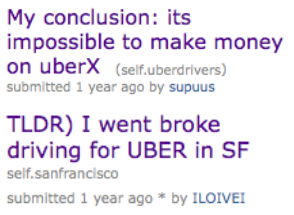
The Uber business technique (6 lessons that can earn your online business 6 figures)
IWT is all about helping you start and grow a successful online business. And even if you’d rather shovel horse manure than be a driver, you’d be crazy to ignore the 6 lessons Uber drivers can teach you about distancing yourself from the competition online.
So let’s get started.
I love studying other businesses.
If you pay attention to the top dogs in any industry, you’ll notice they do far better than their competitors.
Take Uber drivers. On one hand, you can find Reddit threads with those that are barely scraping by:

And on the other, you have some earning more than most people with graduate degrees:

Lesson #1: Use small touches to get massive results
All Uber drivers go through a crash course on how to offer good service. A 13-minute video covers common courtesies like: Opening the door for passengers, having extra phone chargers on hand, serving bottled water, and looking professional.
However, people who really crush it know these are bare minimum requirements. They look for other ways to go above and beyond. And it’s usually small unexpected touches that people take note of.
One guy named Harry Campbell, who has a blog and podcast for rideshare drivers, recommends taking a ride as a passenger to research the competition. When he did this, he noticed there was a big difference between drivers who got 4.9 ratings versus 4.6.
For example, he realized it was annoying to get bombarded with questions the moment he got into the backseat. “Do you want a bottle of water? Do you want me to change the radio station? Is the temperature okay?”
It was a much better experience for the rider if the driver spaced the questions out. “Do you want a bottle of water?” Wait a few minutes then ask, “Do you want me to change the radio?”
Another thing he noticed was that some drivers don’t have their phones mounted. They’re constantly looking down to see where they’re going. A driver probably doesn’t notice this. After all, they’re doing this all the time.
But to a passenger, this can feel unsafe. And the solution is a $15 phone mount that you can put on your dashboard.
Customer research is one of those things you hear about and say, “Yeah, yeah, I know. I got it.” But in reality, few people ever do this, meaning they miss out on the small touches that can bring massive business results. Consider Jacqui Pretty of The Grammar Factory. She created a simple research framework that let her double her conversions and triple her prices.
You can follow her exact steps to boost your business.
Lesson #2: Stop trying to feel busy all the time
When you’re a professional driver, it can feel like you’re busy and working whenever you’re cruising around. But according to Emily Guendelsberger, that feeling is deceptive. Emily is a journalist who went undercover for a month as an Uber driver and documented her experience in Philadelphia’s City Paper.
She recommends not driving around aimlessly in hopes of picking up a ride. It’ll only add costly wear and tear to your car. Instead, stick to a central area where people come and go. Oh, and avoid the suburbs at all costs. You usually wind up driving much farther to pick up passengers.
This is a great lesson on leverage. Which activities produce the biggest results for your business?
IWT’s CEO and founder, Ramit Sethi, is a big believer in focusing on the 1-2 things that’ll produce the biggest results. He calls them Big Wins. And he sees countless business owners printing business cards, creating social media accounts and designing logos when they’re just starting out.
Much like driving a car around aimlessly, these are just ways to make you feel busy and productive. In reality, they’re major time sucks that don’t move the needle on the only metric that matters: Sales.
Ramit says it’s much better to focus on getting 3 paying clients by going directly to them with a compelling pitch and offer. Once you do that, you know you’re onto something. And getting more clients becomes a breeze.
However, the money going into your bank account from these sales only tells part of the story. And that brings me to my next lesson.
Lesson #3: Don’t drool over big numbers
Uber has claimed that their drivers make $90,000 a year on average. However, numerous articles online say that’s a drastic overestimate.
After you account for service fees, tolls, insurance, and other expenses, the typical driver makes close to what a cab or bus driver would make.
And that’s a great lesson for any business owner: Know your expenses.
Remember, profits are what business owners get to keep after they pay their expenses. If you do a product launch that brings in $10,000, but you had to pay $5,000 to rent a recording studio and another $2,000 to hire a video guy, that leaves you with $3,000.
To make more, you have to sell more units. Or you need to charge more per unit.
Yes, examining expenses is like looking at your credit card charges after a night out on the town. It’s not always pretty. But it never lies. And in the case of business, this insight can guide your strategy.
It’s part of the math of online business.
Lesson #4: Play in lucrative markets
Buzzfeed analyzed the pay of 11 full- and part-time Uber drivers. They made anywhere from $3.99 an hour to $31.44 an hour (after expenses).
The second highest paid driver was a 21-year-old student who made $29.57. He’s making double what some drivers make despite working half the hours.
How does he do it?
Simple. He plays in the most lucrative markets. He only drives during the late night rushes when fares rise in response to demand.
And this demonstrates an important business concept called the Pay Certainty Technique. It consists of two parts: First, the ability to pay, and second, the willingness to pay.
People who attend sporting events or concerts and stick around for last calls at bars typically have jobs. How else would they pay for everything? That’s the ability to pay.
After a night out, they’re tired and just want to get home. They’d probably pay extra to not have to wait around for a ride. And whether it’s reality or just the alcohol kicking in, that’s the willingness to pay at work. Drivers who capitalize on this will reap the rewards.
The same applies for online business.
Fitness coaches can target college students who might have a willingness to get in shape but probably no ability to pay. That’s a recipe for failure. Or they can go after busy executives who realize being healthy will keep them energized throughout their busy days (willingness). And they make a small fortune in salary and bonuses, so their ability to pay isn’t in question.
Business owners who recognize who they’re targeting with their products and services can make double what everyone else in their industry makes.
…but you don’t have to take the same path as everyone else. How would it look if you designed a Rich Life on your own terms? Take our quiz and find out:
Lesson #5: Let others speak for you through social proof
Passengers have the chance to rate their drivers on a scale of 1 to 5 stars after a driver drops them off. All the passenger ratings combine to create an average rating that any potential riders can see.
The higher the rating, the safer a passenger can feel about getting to his or her destination on time. A lower rated driver might be passed over in favor of a higher rated one. Plus, any driver who dips below 4.6 is at risk of getting the boot from Uber.

Uber builds social proof into their app.
This is social proof in action. People don’t have the time to personally vet potential drivers, so they default to the collective wisdom of the crowd. “If all these people say this driver is legit, he must be!”
This same concept applies when you buy books off Amazon or choose which hotels (or Airbnbs) to stay at, and it matters for your online business.
When visitors land on your site randomly, they unconsciously look for signals of social proof to determine if you’re legit.
Which is why IWT recommends 4 ways to add instant social proof to your website. Just another lever you can pull to set yourself apart from others.
Lesson #6: Get everything you can out of all you’ve got
When most people think about making money from Uber, they think about becoming a driver. And they completely ignore the other ways to make a buck from this trend.
Consider Sam Dogen, who runs the popular personal finance site Financial Samurai.
He makes $167.97 an hour through Uber — the equivalent of $347,000 a year if it were a full-time job.
But most of that income doesn’t come from driving. It’s from referring other drivers through a special code on his site.
As a top referrer in the Bay Area, he was invited into Uber offices where he met other top referrers. Some of them make $200,000 to $300,000 a year just from recruiting other drivers.
Then there’s the story of Gavin Escolar, the Filipino man best known as the “Uberpreneur” who makes $252,000 a year.
He immigrated to San Francisco to start a jewelry business. When that didn’t pan out, he turned to Uber as a way to help pay the bills.
He discovered that most passengers wanted to talk during their rides. He always brought up his jewelry business, and people always asked for business cards. He didn’t have any, but that’s when a brilliant idea hit him.
Why stop at business cards? Why not showcase the jewelry in his car?
That’s exactly what he does. However, he never solicits business. He only answers questions whenever asked. And according to a Forbes interview, he always steers the conversation towards the wants and needs of the customer.
This is the mark of a great salesman, and it explains how he’s able to sell $18,000 worth of jewelry each month.
(Related: How to sell in a way that’s not sleazy)
Had it not been for Uber becoming mainstream, his dream of selling jewelry would not have been possible.
Which is why it’s important to pay attention to big trends — they create new opportunities for clever entrepreneurs. With a little creative thought, you can look around and find ways to build lucrative businesses.
The internet gave way to the world wide web. That attracted millions of people to various sites and opened the floodgates for advertisers, ecommerce, affiliates, and many more opportunities for everyday people to become entrepreneurs.
The only question you have to answer is: What kind of business do you want to have?
If you liked this post, you’d LOVE my Ultimate Guide to Finding Your First Profitable Idea
It’s one of the best things I’ve published, and totally free – just tell me where to send it:



